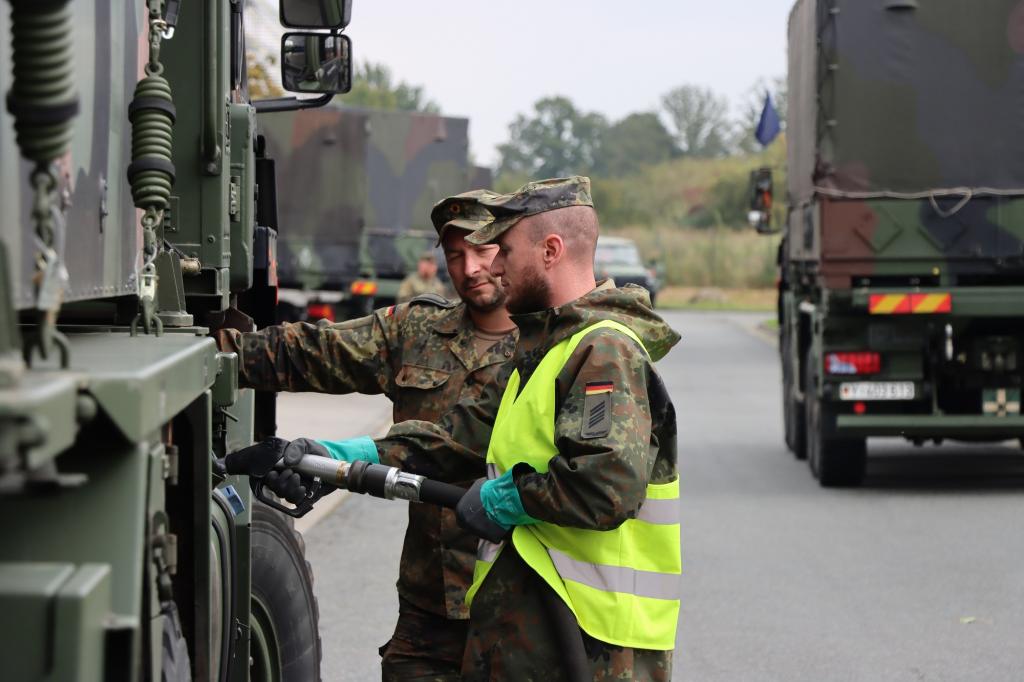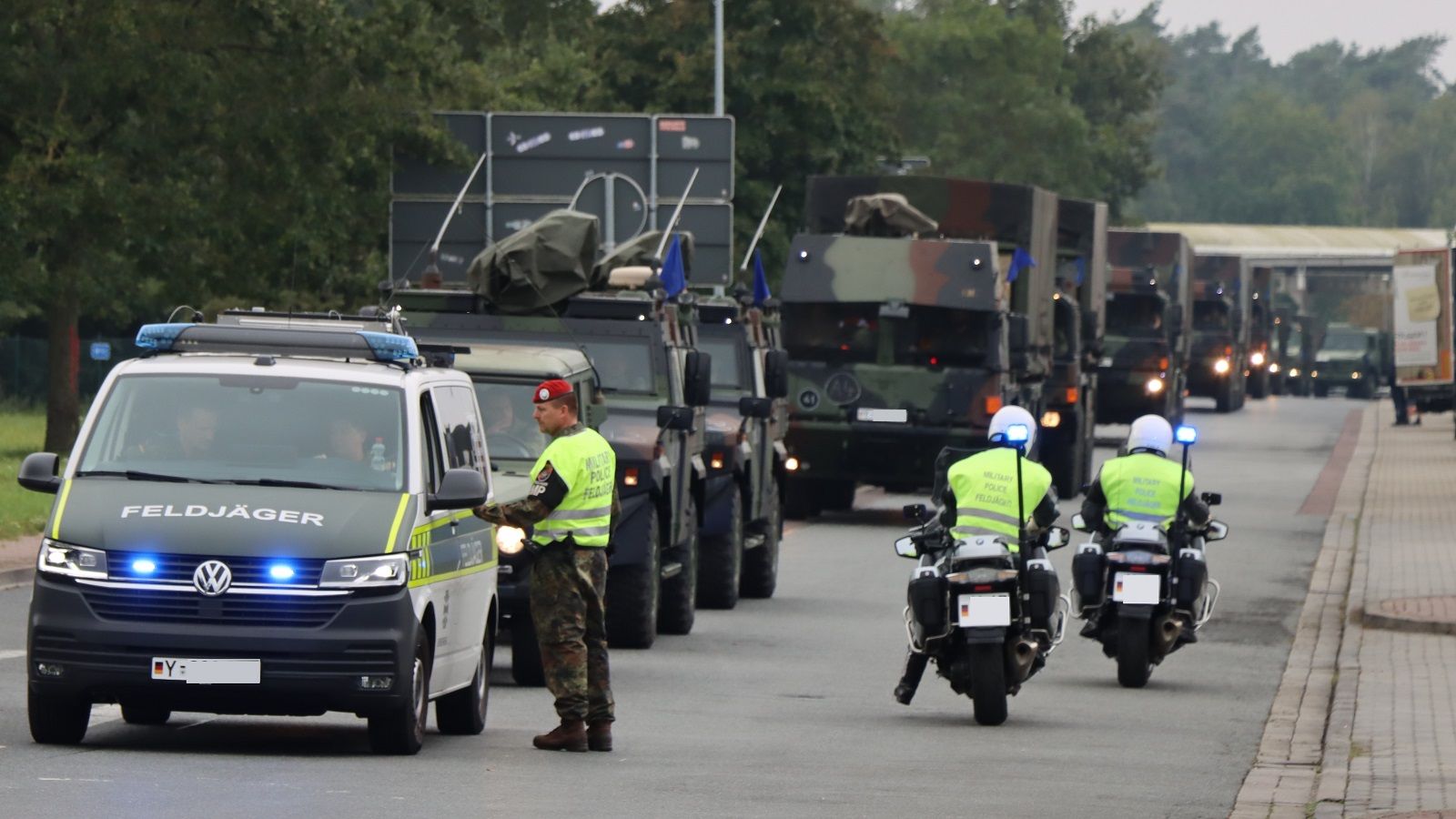Get the weekly SPARTANAT newsletter.
Your bonus: the free E-Book from SPARTANAT.

On September 20, the Multinational Command Operational Control of the Bundeswehr in Ulm successfully completed an inspection of the first European NATO model corridor for military traffic. This corridor includes the three European countries of the Netherlands, Germany, and Poland. The multinational exercise "DeployEx 2024" was intended to test newly introduced cross-border procedures and processes. Since September 18, a march column of Bundeswehr vehicles has been driving over 1,000 kilometers from the Netherlands through Germany to Poland, making several stops along the mostly highway route. This included a military gas station set up at the Zweidorfer Holz rest area along the A2 federal highway.
Military Mobility - rapid troop movements within NATO
At the beginning of the year, the NATO Support Command Joint Support and Enabling Command, or JSEC, in Ulm was tasked with setting up the corridor from West to East. It coordinates all troop movements of the security alliance in Europe, establishing procedures for cross-border movements of military forces. These procedures were previously standardized and defined in a trinational working group of the Netherlands, Germany, and Poland. The corridor now being tested is part of a Military Mobility project that strengthens the European pillar of NATO as a flagship project.
Standards, fixed procedures, and corridors serve to expedite processes within the armed forces, as well as between different member states.

Coordination by Territorial Command
The Territorial Command of the Bundeswehr in Berlin, responsible for all military movements through the "German hub," was the third entity involved in the exercise. As the coordinating command, it was responsible for ensuring smooth operations on the operational level before and during the multi-day military exercise.
Lieutenant General André Bodemann, the commander of the Territorial Command, positively assessed the project: "Rapid NATO troop movements are a crucial contribution to credible deterrence and the defense of the alliance. Military Mobility is of strategic importance for Germany as a geostrategically central transit nation in Europe. This elevates it to a new level."
In Berlin, the necessary supply facilities for troop movements, as well as accommodation and catering for soldiers along the route in the Netherlands, the federal states of Lower Saxony, Saxony-Anhalt, and Brandenburg, and in Poland were planned and established. All necessary arrangements were made with the armed forces of the Netherlands and Poland, as well as the authorities responsible for border traffic. The experiences gained from the exercise will now be used to further optimize processes overall.
Following the inspection, General Bodemann, as the commander of the unit, expressed his satisfaction: "The German hub has once again worked well. We have demonstrated how the Bundeswehr fulfills its responsibility in the center of Europe with regard to deterrence and the defense of the NATO alliance."
The establishment and operation of the Three-State Corridor sets an example for all future NATO corridors. Germany is reaffirming its commitment to taking a leading role in Military Mobility within NATO and the EU.
The Bundeswehr plans to further enhance its capabilities for logistical support, traffic management, and protection of partners in the EU and NATO during their stay in Germany.
Background: Military Mobility, PESCO, and Deterrence
The successful testing of the corridor for troop movements in Europe is the result of political agreements among the participating nations in January 2024. During an EU Defense Ministers meeting in Brussels, the establishment of a cross-border movement lane for military traffic from West to East was decided. The goal is to establish a "Military Schengen" to accelerate troop and material transports throughout Europe. NATO and the EU collaborate closely on various Military Mobility projects.
The Bundeswehr supports friendly nations in their movements to and through Germany and has been involved in a Permanent Structured Cooperation project, or PESCO, for years. This project accelerates European procedures, with the EU's Military Mobility project simplifying, standardizing, and expediting procedures for troop movements. This initiative also aims to stimulate and advance the modernization of transportation infrastructure. With Military Mobility, friendly forces can more easily relocate personnel and materials across borders to quickly reach exercise and deployment locations, such as the NATO Eastern flank.

From Western Europe to the NATO Eastern Flank
This involves organizing military traffic from West to East in the event of an alliance crisis, focusing on the transport of troops, materials, and supplies from major Western European ports on the North Sea to the NATO Eastern flank. Since Russia's illegal actions in 2014, NATO has continuously reinforced its troop presence in Eastern Europe for deterrence. Quick reinforcement must reach the Eastern flank for exercises and operations in case of threats.
Operational Command takes over coordination
In the future, the Operational Command of the Bundeswehr will be the central point of contact for operational matters for allies and multinational organizations like NATO and the EU, as well as for German authorities and organizations. It will assume military security tasks at the federal and state levels, including coordinating troop movements in and through the "German hub." Currently, the Territorial Command and the Operational Command work closely together.
GERMAN ARMED FORCES online
SPARTANAT is the online magazine for Military News, Tactical Life, Gear & Reviews.
Send us your news: [email protected]
Ad
similar
Get the weekly SPARTANAT newsletter.
Your bonus: the free E-Book from SPARTANAT.


